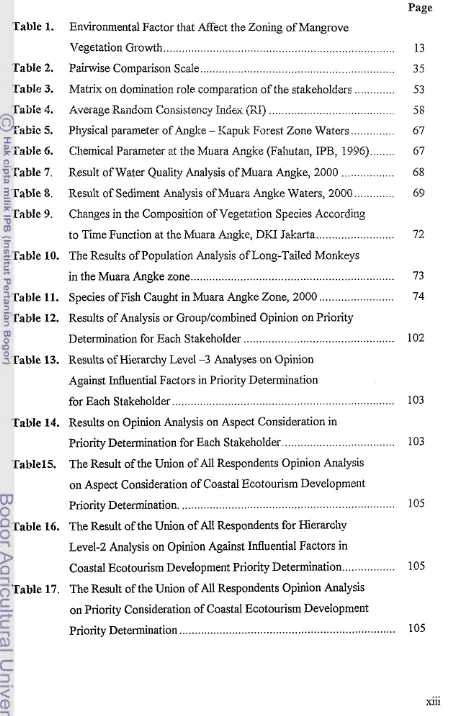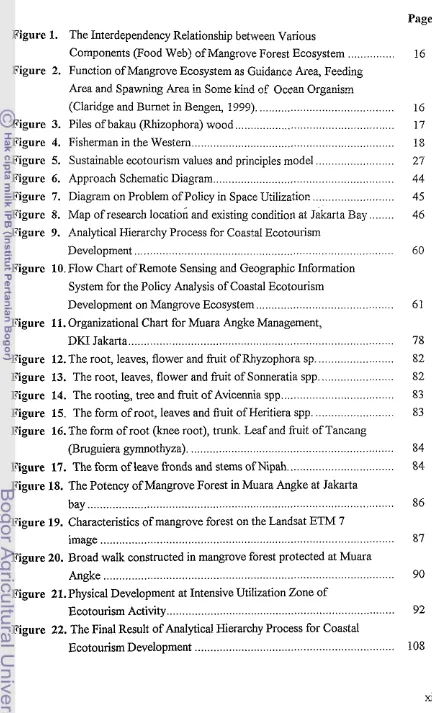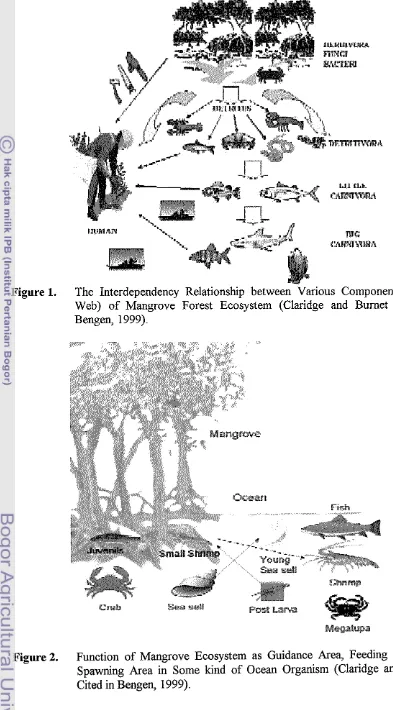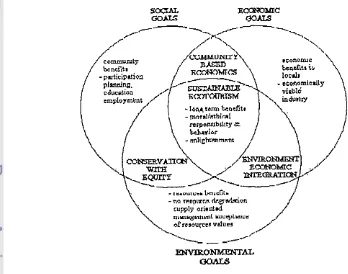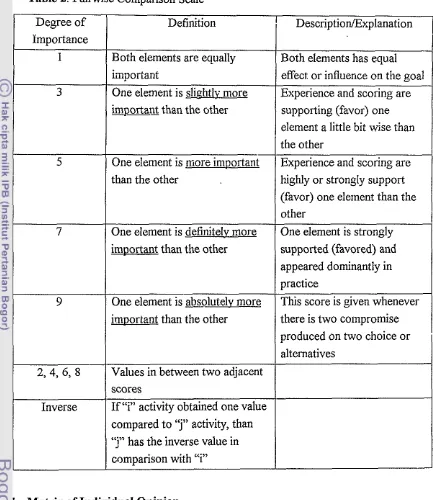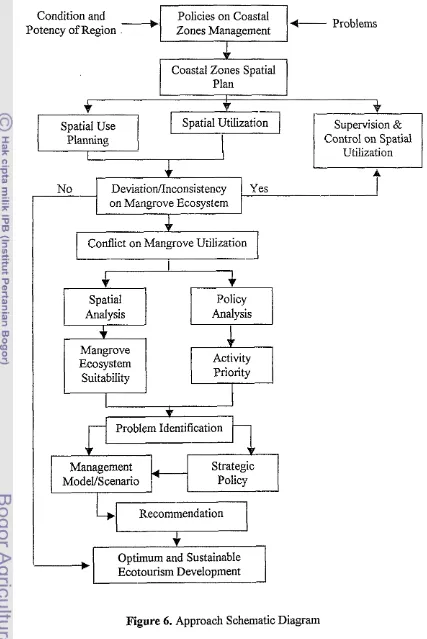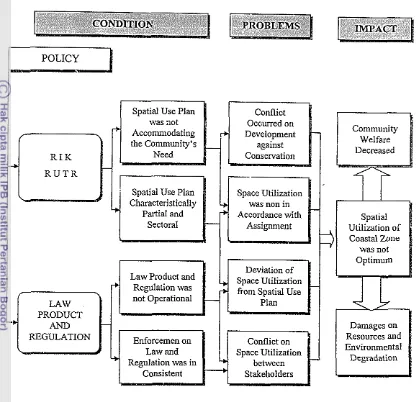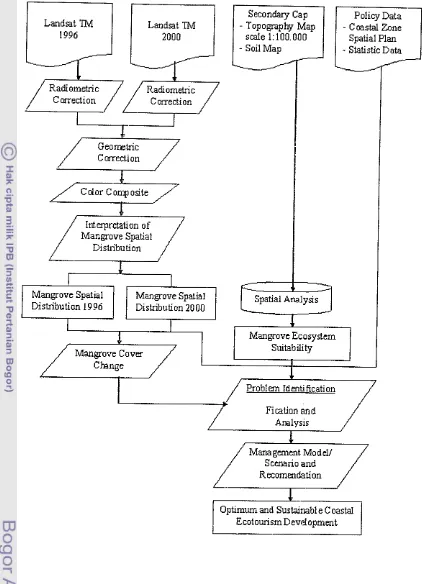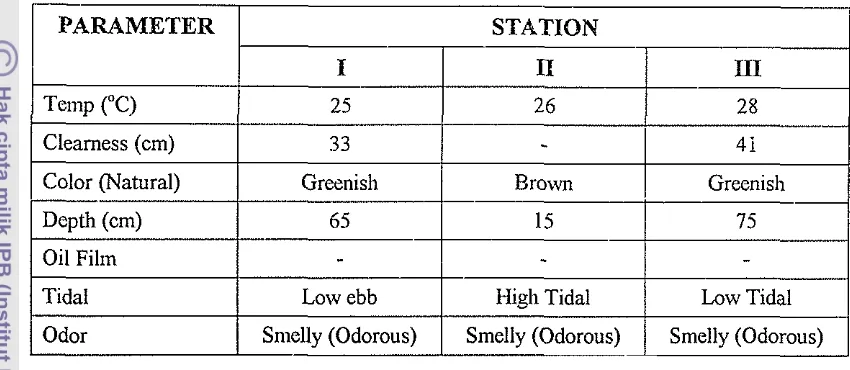POLICY ANALYSIS OF COASTAL ECOTOURISM
DEVELOPMENT ON MUARA ANGKE MANGROVE
ECOSYSTEM, JAKARTA BAY, INDONESIA
By
:MYINT THU ZAR
(SPL 99803)
COASTAL AND MARINE RESOURCES MANAGEMENT STUDY PROGRAM
GRADUATE PROGRAM
BOGOR AGRICULTURAL UNIVERSITY
BOGOR INDONESIA
POLICY ANALYSIS OF COASTAL ECOTOURISM
DEVELOPMENT ON
M U A M
ANGKE MANGROVE
ECOSYSTEM, JATKARTA BAY, INDONESIA
By:
Niyint
Thu
Zar
SPL
99803
Thesis Submitted to Graduate School of
Bogor Agricultural University (IF'B), Indonesia In Partial fulfillment of the requirements for the degree of Master of Science In Coastal and Marine Resources
Management Study Program
COASTAL AND MARINE RESOURCES MANAGEMENT STUDY PROGRAM GRADUATE PROGRAM
BOGOR AGRICULTURAL UNIVERSIl17 BOGOR INDONESTA
Myint T11u Zar. Policy Analysis of coastal ecotourism development on Rluara
Angke Mangrove Ecosystem, Jakarta Bay, Indonesia. Under Supervision of Dr. Ir.
Dietriech G. Bengen, DEA., as a Chairman and Prof. Dr. Ir. Daniel R. Monintja as
a member.
ABSTRACT
The mangrove ecosystem is one of important ecosystems in the tropics and has a great econcmic and -cotourism poientizls. The :nultip!e roles of xczgrovc: ecosystems i?. coastal C C G ~ O U ~ ~ S ; ~ ~ areas are aow v?e!l recognize in Indonesia. Ecoto!~xi.sm i:: ecologically sustainabie tourism that related with forest environmental and cultural understanding, appreciation and conservztion.
Information on mangrove ecosystems of the Jakarta Bzy is mostly concerned with the flora and fauna aspects. The mangrove ecosystems in the area have a vcly limited diversity. The importance of Inangrove forest p:oductivity in the function of the coastal ecosystem of Jakarta Bay cannot ignore. A lot of development activities have iiegatively afiected t!iis area. The balance between economic gain and environment socizl loss should be weigh?ed ill fairor of the longer - term objectives so that estzblishment of susiaiiiable resources deveIopment will not be ignored. Attention should also pay to the impact of coastal ecotourism development on the sustainability and conservancy of mangrove ecosystem; This research conducted from September to November 2001 at Muara Angke of North Jakarta in Jakarta Bay. This research aimed to:
(1). To examine the environmental suitability of mangrove ecosystem and coastal area for ecotourism development,
(2). To obtain the optirnum plans for the associated enterprise in relation to variables and parameters which relate the potential use of physical, economic and institutional restraints while considering the objectives of entrepreneur and policy planners,
(3). To recommend the appropriate mangrove areas for ecotourism that
would have the least effect for the coastal environnent and the social activities of the local people.
Geographic Information System (GIs) method used for evaluating the mangrove
ecosystem and Analytical Hierarchy Process approach used for resolving the spatialfland use conflict to evaluate policy. The software program Expert Choice (3.1)
has incorporated in the AHP methodology and enables the analyst to structure the hierarchy and resolve the problem using absolute measurement as appropriate.
The result showed that all along the Northern coast of what now is DKT Jakarta was originally mangrove forest ecosystem, complete with all richness of Bio-diversity attained in it. However Indonesia should utilize institutional facility presently available as soon as possible, such as forestry agency, tourism agency, and other related institutions, which can act professionally and responsible in the effort to develop coastal ecotourism better, especially mangrove forest ecosystem, therefore a coastal ecotourism project can be sustainable.
Myint Thu Zar. Anrrlisa Kebijaknrz nrtrgenni Penger~rbangntr Eko-parilvisatn (Z(iern11 Pesisir pado Ekosistet~r Mangro17e Muarn Atrgke,Teluk Jnknrta,Ztzdonesia. Dengar1 bimbingan Dr. Ir. Dietriech G. Bengen, DEA., Prof. Dr. Ir. Daniel R. Monintja.
Mangrove ekosistem rnerupakaii salali satu ekosistem penting di daerah tri\cpika dan memiliki potensi ekonomi dan eko-pariwisate yang luar biasz. Aneka ragam peianana ekosistem mangrove pada eko-pariwisata daerah pesisir di Indonesiz pada saat ini diak.ui seca1.a iuas. Zko-pasiwisata adalah kegiatal? pariwisata yang seczra iingkutljgn (ekologis) bericesinambungan, yang bersangicuran dengan pemahaman; penghargaan dail pelestarian lir~gkungan dan budaya.
lnformasi rnengenai ekosistem n:angTove di Teluk Jakerta sebzgian besai berkaitali dengan aspek floia dan fauna. Ekosistem mangrove di daerah. ini mempunyai keiagarcan yang sangat terbatzs. Pentingilya produktivitas ekosistem mangrove da'lqi fui~gsi-fungsi ekosistem pesisir di Teluk Jakarta tidak dapat diabaikan begitu saja. Banyak kegiatan penlbang~nan yanz berdampak negatif pada wilzyah tersebut. Suatu kesetimbangan antara keuniungan ekonoiris dan kerugian-kerugian sosial dan 1ingk:cngan baruslah diberi bobot yang patut demi tujuari-tujuan jangka pai~jang
sehingga terbentuknya pemanfaatadpengembangan suinberdaya yang
bcrkesi!1ambunga1 tidaklah disia-sial:an. Perhatian hendakGya diberikan terhadap dampak pengembangan eko-pariwisata pesisir terhadap kelestarian ekosistem mangrove. Penelitian ini dilaksan&an dari bulan September sampai dengan November 2001 di daerah Muara Angke Jakarta Utara di Teluk Jakarta. Penelitian ini dimaksudkan untuk:
(1). Mengkaji kesesuaian linglmngan ekosistem mangrove dan wilayah pesisir
guna pengembangan eko-pariwisata,
(2). Memperoleh perencanaan optimal guna usulan-usulan yang berkaitan
dengan eko-pariwisata, yang berhubungan dengan variabcl (peuhah) dan parameter yang berhubungan dengan penggunaanpotensi dari kendals fisik, ekonomi dan kelembagaan dengan memperhatikan pertimbangan- pertirnbangan sasaran yang ingin diraih oleh pengusaha dan perencana kebijakan,
(3). Merekomendasikan daerah-daerah mangrove yang sesuai untuk eko- pariwisata yang akan memiiiki/mendapat dampak terkeeil terhadap lingkungan pesisir dan kegiatan-kegiatan sosial dari penduduk setempat. Sistem Informasi Geografis (SIG) dalan evaluasi kesesuaiari ekosistem
mangrove sedangksn Proses Analisis Hirarki
(AH?)
diterapkan dalam rnencaripenyelesaian kolfflik-konflik penggunaan ruangAahan. Piranti lunak Expert Choice versi
3.1 digunakan dalam penge jaan AHP (Proses Analisa Hirarki) dan memungkinkan
penganalisa dalam strukturisasi hirarki dan memecahkan masalah dengan memakai penilaian absolute bilaman diperlukan.
Sepanjang pantai utara DKI Jakarta pada mulanya mer~pakan ekosistem hutan
mangrove dengan kekayaan keanekaragaman hayati yang terdapat didalarnnya. Hasil akhir menunjukkan bahwa Indonesia sebaiknya memanfaatkan fasilitas kelenlbagaan yang tersedia sekarang dengan secepat-cepatnya, misalnya pihak kehutanan, agen-agen pariwisata dan lembaga terkait l a i ~ y a , yang dapat bertindak secara profesional dan bertanggung jawab dalam upaya membangun eko-wisata pesisir yang lebih baik, khususnya dalam ha1 ekosistem mangrove, sehingga proyek ekowisata pesisir tersebut dapat berkesinarnbungan.
liesearcl~ Title : Policy Analysis of Coastal Ecotourisln Developlnent on Muara
Angke Mangrove Ecosysten~
,
Jakarta Bay, IndonesiaStudent Name : Myint Thu Zar
Stndent ID : SPL 99803
Study Program : Master of Science in Coastal and Marine Resource
Managenlent
The Advisory Committee approves this thesis
4 Dr. Ir. Dietriech G. Bengen, DEA.
Chairman
Prof. Dr. Ir. Daniel R. Monintia
Rle~nber
1-lead of Stutly Program Director of Graduate Program
Dr. Ir. R o k l ~ ~ n i n Dahuri, MS
STATEMENT ON THESIS AND SOURCE O F INFORMATION
I here with declare that this thesis "Policy Analysis of Coastal Ecotourism Development on Muara Angke Mangrove Ecosysteni, Jakarta Bay, Indonesia" is my own work and has not been submitted in any form for another degree or diploma programme (course) to any University or other institution of tertiary eclucation. Source
of information derived or quoted from the published or unpublished work of others has acknowledged in the text and a list of references made at the end of thesis.
Bogor, January 2002
Myint Thu Zar (SPL.99803)
STATEMENT ON ACCESS TO THIS THESIS
I, the undersigned, the author of this thesis, understand that Bogor Agricultural University (IPB), Indonesia will make it available for use within the University library and, by microfilm or other photographic means, allow access to users in other approved libraries. All users consulting this thesis will have to sign the following statement:
"In consulting this thesis, I agree not to copy or to closely paraphrase it in whole or in part without the written consent of the author; and to make proper written acknowledgelnent for any assistance which I have obtained from it."
Beyond this, I do not wish to place any restriction on access to this thesis,
Bogor, January 2002
BIOGRAPHY OF AUTHOR
The author was born in Mawlamyine, The Union of Myanmar on the date of 5" October 1969. She is a daughter of Mr. (U) Myint Thein (Head Master) and Mrs. (Daw) Aye Yi (Teacher). She has three brothers and one sister.
She finished her Elementary, Junior, and High school in No.6 Basic Education High School, Mawlamyine, The Union of Myanmar. During her schooldays in State High School she got outstanding prizes for school subjects from Kindergarten to Metric class.
M e r her Matriculation, she joined the Yezin Agricultural University, The Union of Myanmar and obtained the Degree (B.Agr. Sc.) Bachelor of Agricultural Science with Credit in the year 1993. When She was in University, She participated in Flowers Association and Mon Literature and Culture sub- committee as an executive member. Moreover she was a Secretary of Na Win Hall (Girls Dormitory).
Since March 1994 after graduation from the University, Minister for Ministry of Agriculture and Inigation has appointed her, to work in the Myanma Agriculture Service, State Manager Office, Mon State that was under the Ministry of Agriculture and Irrigation, The Union of Myanmar as a Supervisor until the end of May 1996.
Her interest is Agricultural Research works and teaching the students to share her knowledge for this reason. She tried to apply for the University teacher at the Yezin Agricultural University, The Union of Myanmar in June 1996. Then she became a teacher in the Department of Agricultural Botany at Yezin Agricultural University, Myanmar. While working there, She studied M.Sc. course works for Plant Breeding till the end of 1999 at the Yezin Agricultural University, Myanmar.
In December 1999, she passed the exam for SEARCA' s scholarship to pursue her study for Master Degree Program in the Coastal and Marine Resource Management Study Program at Bogor Agricultural University (IPB), Indonesia. She started her Master Degree Program in the second Month of year 2000 through a scholarship of South- East Asian Ministers of Education Organization (SEAMEO), Regional Center for Graduate Study and Research in Agriculture (SEARCA), SEAMEO SEARCA. She was no adequate background for that subject but she had tried her best.
During her study in Bogor Agricultural University (IPB), Indonesia, she got the opportunity to participate in the JSPS International Symposium on Fisheries Science in Tropical Area, Sustainable Fisheries in Asia in the New Millennium sponsored by Japan
on August 21"-25", 2000, International Workshop COASTMAN- International
Network for Training in Integrated Coastal Zone Management sponsored by Germany in 17"-21* September, 2001 and International Training Course on Remote Sensing and Geographic Information System for Coastal Applications sponsored by UNESCO and
SEAMEO BIOTROP on the dated of 23'"ctober to 1" November,2001.
ACKNOWLEDGEMENT
In the narne of God, the Most Beneficent, the Most Merciful. Glory is to you;
we have no knowledge except what you have taught us. Verify it is you, the All- knower, the MI- Wise. First, I would !ike to express my deepest gratitude to Gcd the Al Mighty for 14s Mercy, Favor, Blazing me to cany out this task with sound health
and mind.
I wish to express my Earnest thanks and Sincere appreciation to the
Government of the Union of Mjjanmar, Mil~ister for Ministry of Agriculture and
Irrigation, Minister for Ministry of Higher Education of Myanmar, my special Kind
and Respected Dr. Kyaw Than, tne Rector of Yezin Agricultural University, Myanmar
for their official endorsemen:, kindly permission, allowed me to attend the Master
Course on Coastal and Marine Resource Management Study Program in Bogor
Agricultural University (IPB), Indonesia.
My especially heartiest gratitude and heartfelt appreciation due to Dr. Ir.
Dietriech G. Bengen, DEA and Professor Dr. Ir.Danie1 R. Monintja, who acted
Respectively as my respected Chairman and Member of Advisory committee and who
introduce me to the topic "Policy Analysis of coastal ecotourism development on
Muara Angke Mangrove Ecosystem, Jakarta Bay, Indonesia", I am deeply
appreciate and respected them for their constant guidance, continuous encouragement,
valuable suggestion, good advice, constructive criticism, technical comments in
Preparation the Manuscript, kindly providing over all supervision during my study in
Indonesia. I really wish there were some way of showing my gratitude for all they hhsve
done for me.
I am very gratehl thanks to the Goverrlment of Germany, which is
administered by the Southeast Asian Ministers of Education Organization
(SEAMEO), Regional Center for Graduate Study and Research in Agriculture
during of my two years Master Degree study which without this support, this Degree
would not be possible. I am deeply appreciated.
~Zly Thanks are also due to Dr. Ruben L. Villareal the SEARCA Director, Dr.
Soekartalvi Deputy Director of SEhP,C& and Dr. Edith Cedicol GEID oficer of
SEARCA as well as other SEARCA Officers.
Thazks zre extenced to the kcad of the study prcjgian, Dr. I;.. Rolthnlin Dahuri
MS
(Presently Minister for Ministry of Marine AfFairs and Fishery), Professor Dr. Ir.Jacub Rais, Dr. Ir. Tridoyo Kusurnastanto and ail of my Lecturers in Bogor
Agricultural University (IPB), Indonesia, who shared me precious knowledge for my
future. 1 am the highest thanks to them for their deep understanding about my Language
(Bahasa Indonesia) problem during my course works study in the regular ciass. Thank
you very much for all of their Kindness and help.
I would like to express my most grateful thanks to Rector Prof. Dr. Ir. K. M.
Aman Wiranatakusumah, M.Sc. and Professor Dr. Syafrida Manuwoto, M.Sc.
Director of Graduate Program, Bogor Agricultural University (IPB), Indonesia, who
always provided kind attention and forced me to do the best for their support
adnlinistration.
My sincere gratitude and appreciation went to Professor
U
Han Nyunt and,Teachers from the Department of Agricultural Botany, Yezin Agriculturai
University (YAU), Myanmar, for each of them shared and conducted my regular duty
during my study in Indonesia. Thank you very much for their kind assistance.
I would also like to extend my thanks to staff of Graduste Program IPB, who
kindly helped me in the process of my academic regulation as we!l as to the Coastal
and Marine Resource Management Study Program Staffs for all the best support,
providing facilities, services and kindly friendship.
I
am very gratefully acknowledges to our Ambassador, Staffs and their familyfrom the Embassy of the Union of Myanmar at Jakarta- Indonesia and my sincerely
I am always remembering for the all happy times we had together in Indonesia, how's
wonderful life we had It will always be on my mind
My thanks are due to Drs. Soebagio, M M (Walikota of North Jakarta), Ir.
Darjamuni M.Si (Head of Fishery Department), Drs. A.Z. Harahap, M M (I-Iead of
Tourism Office), Er. Nyolo Santoso, M.Si (Head of Muara Angke Natural Sanchrary
and his wife Drh. Ria Furyacti Yahya
,
M.Si (Admicistrative staff of SPL studyprogram), Mr. Ir. R J. Moermanto, MS for their willingness to contribute the necessary data and information to illy research. I am really greatly appreciated.
I especially grateful to appreciate the advice and assistance of my friends afid
my Colleagues, Yopi, Iclia, Erick, Arifin, Noni, Ocha, Erin, Fis and ail of my
classmates in SPL Study Prosram (3" batch, 4'' batch, 5"' batch), especially Deky,
Johana, Parman, Yuanike, Dian, . b a n , Agus, Pri, Lilik, Ebest, Sri, Milka, for our
deeply friendship, helphl advice and willingly gave helping hands, to my friend in the
"same Boat", I really appreciate our togetherness, our 24-I-Iours-a-Day Works, and how
we support each othei to finish our study right on time.
I am deeply Indebted to nly lovely Aunt for her full supporting, sacrifice, good advice, kindly patient me with her love, which made this study possible and led to a
successfUl completion. 1 am very appreciated.
Last but not least, the most profoundly and deeply appreciation must go to my
beloved Mom, my three Brothers, and one Sister for their permission, their love, their
motivation and their prayers. I am really most grateful to them.
There is marly people left that I should thank for this task that is not mentioned
individually. I wislt to show my appreciation for what they have done.
. .. . .
I dedicated this Thesis to Our Golden Land Union of Myanmar, my Mother
University Yezin Agricultural University (YAU), my Beloved Mom and my Lovely
Aunt, to whom this piece of rny task as an expression of my respect and admiration.
The Author
Myint Thtr Zar
PREFACE
All praise is unto to Thee, Lord the Almighty, whose Grace and Guidance made
it possible for me to finish and submit this Thesis, which is Partial fu!filln~ent of the
requirements for the degree of Master of Science In Coastal and Marine Resources
Management Study Program, Bogor Agricultural University OPE), Indonesia.
The title of the Thesis is "Policy Analysis of Coastal Ecotourism
Development on Muara Angke Mangrove Ecosystem, Jakarta Bay, Indonesia." In
short, the research would be focused to study the possibility of mangrove forest zones
for coastai ecotourism development purposes and assessing policy related to that.
Allow me to express my gratitude to Dr.
Ir.
Dietriech G. Bengen, DEA., as theChairman of Advisory committee and. Professor. Dr. Ir. Daniel Monintja as the
member of Advisory committee, who had put great effort in directing and providing
precious suggestion and input to me, in preparing this Thesis.
I would also like to express very grateful thanks to my Sponsor, Southeast
Asian Ministers of Education Organization (SEAMEO), Regional Center for
Graduate Study and Research in Agriculture (SEARCA), SEAMEO SEARCA for
their financial support by awarding me the Scholarship during two years of my Master
Degree study progamme.
I felt sure that this Research was far from perfect. Therefore, I kindly asked
further direction, suggestion, input and criticism to make it better. Finally, I hoped that
this research result and the subsequent research work would benefit the reader and other
students.
Bogor, January 2002 The Author
Myint Thu Zar
TABLE OF CONTENTS
ABSTRACT
...
APPROVAL OF ADVISCRT7 COMMITTEE...
STATEMENT ON THIZSIS SOURCES IIVFO~YIATIBN AND ACCESS..
BIOGRAPHY OF AUTHOR...
ACKNOWLEDGEMENT...
PREFACE...
TABLE OF CONTENTS
...
;...
...
LIST OF TABLES
LIST OF FIGURES
...
...
...
LLST OF APPENDIX
.
.
I
.
INTRODUCTION ... 1.1 Background...
1.2 Statement of the Problem...
. .
...
1.3 Objective of the Study
...
I1
.
LITERATURE REVIEW...
2.1 The Role of Mangrove Ecosystem
.
.
2.1.1 Mangrove Forest Coildition
...
2.1.2 Mangrove Ecosysteln...
Basic characteristics of mangrove forest ecosystems
...
. .
...
Abiotic and biotic components
. .
...
Abiotlc components...
Soil...
OxygenNutrients
...
Winds and curients
...
Light. temperature and humidity
...
...
...
Tides
:
. .
...
...
Salinity ;
...
Biotic components
...
Vegetation and zonation
Page i
.
. 11 ... 111 iv v...
V l l l
TABLE O F CONTENTS (continued)
Page
2.2 Function of Mangroves ...
2.3 Mangrove Products ....
2.3.1 Non-food ... 2.3.2 Iildirect uses
2.3.3 Potential us-
2.3.4 The changing patterns of mangrove utilization ... 2.4 Mangrove Management Planning ...
2.4.1 Information requirements for mangrove management ... 2.4.2 Planning principles
2.5 Integration andiInteraction of mangrove snanagement with the
development of other sectors in coastzl zones ...
...
2.6 Ecotourism ...
.
.
...
2.6.1 Sustainable Ecotourism
... 2.7 Development politics of Indonesian Government
2.8 Analytic Hierarchy Process (Am)
2.9 Geographic Information System (GIs) ...
.
.
...... 2.9.1 Main components of a geographic information system
2.9.2 Data analysis and modeling with GIs ... ...
2.9.3 Use of remote sensing data in GIs
...
...XII
.
RIETHODOLOGY...
3.1 Approach
3.2 Location and Time of Research
...
n
...
3.3 Analytical Method
3.4 Data collection ...
.
.
...
.
.
3.4.1 D ~ g ~ t a l data processing
...
...
3.4.2 Method for respondent selection
...
3.5 Data Analysis
...
3.5.1 Geographical Information System Method Approach
...
.
1 Defining the problem and the intended solution
...
.
TABLE OF CONTENTS (continued)
Page
3
.
Preparing the Painvise comparison matrix and doingthe cornparation ...
3.5.2 Conflict analysis and fhctian & authority x~a!ysis ...
XV
.
GENEPAL, I)ECRIPTION OF TEE A?&P.
4.1 Forev~ordlBackground ...
4.2 Physical Aspec
4.2.1 The soil and th: topcgraphisei features ...
...
4.2.2 Climate
..
.
...4.2.5 Tidal cycles
...
4.2.4 Salinity
4.2.5 Water quality
...
...4.2.6 Bed sediment
.
.
4.3 Fauna
...
...
4.4 Flora
...
4.4.1 Land covering
...
4.4.2 Monkey population
4.4.3 Fish ...
4.5 The Social-Economic Condition of Community Surrounding
...
the Area
4.5.1 Population
... .... ...
4.5.2 Economics
...
...
4.5.3 Culture
4.5.4 Spatial use of land ...
4.6 Government Policy ...
4.6.1 The menegement of muara angke wildlife sanctuary ...
V
.
RESULTS AND DISCUSSION...
5.1 The Interest of surrounding community
...
... 5.2 Supply (Potency) and demand analysis (Demand on Conservation.
?
...
Function OL Muara Angke)
TABLE OF CONTENTS (continued)
Page
A. The Internal Potency of the Muara Angke ... 81 1. Bio diversity .. ... . .. . ... ... .. ....
....
. . . . .. .
. ... .
. . . ..
. . 8 1 2. The naturalness of ecosystea. .....
... ... ... ... ......
....
.. . . ... ....
S 1 3. Kecreation activity (Demand Analysis) in Ivlcara P~igl:c ... 88B. External potency of Iviuara Angke Area 93
1. Dunia Fantasi (Ijufan) Ancol 93
2. Marine Tourism (Ocean Harbor, TPI Rapuk, Bivalve
Aquaculture, Rambut Island, Uniung Jawa Island,
Pari Island Resort and Bidadari Island Resofi) ... ... 93 3. Shopping c a t e r (Mangga Gua, Glodok, Mega Mall Pluit,
PUC hfall) 4. Sport faciii
5. Protected forest, ?ourism forest, mangrove nursery at Muara
Angke
...
945.3 Social - Culture Aspect ...
.
.
.
...
. . . . .. . .
. . . . 955.4 Visitors Aspe 97
. .
5.4.1 Compotion of vlsltors ... 97
5.4.2 Visitors evaluation on the site 98
5.5 Conflict on Space Utilizatio 100
5.5.1 Conflict between industry, ecotourism, natural conservation &
protection area, and research & natural laboratory ... 102 5.6 Policy Analysis
...
109VI. CONCLUSION AND RECOiMlVPENDATION
113
6.2 Recommendation
.
.. . .
.. . . .
117LIST OF TABLES
Page Table 1.
Table 2. Table 3. Table 4. Tabic 5.
Table 6.
Table 7. Table 8. Table 9.
Table 11. Table 12.
Table 13.
Table 14.
Table 16.
Table 17.
Environmental Factor that -4fect the Zoning of Mangrove
\legetation Growth.. ...
...,
....
.
[image:175.602.82.537.91.807.2]Panvise Comparison Scale ... ... Matrix on domination role comparation of the stakeholders
m
Average Rzndom Consistenzy Index (nl) ... . .... .. Phjjsical parameter of -4ngke - ICapuk Forest Zone Waters ...
Chemical Parameter at the Muara h g k e (Failutan, P B , 1996) ...
R.esult of Water Quality Analysis of Muara Angke, 2000 ... Result of Sediment halysis of Muara .4ngke Waters, 2000 ...
Changss in the Composition of Vegetation Species According to Time Function at the bfuara Angke, DICI Jakrta
...
...
The Results of Population Analysis of Long-Tailed Monkeys in the Muara Angke zone ...
.
.
...... Species of Fish Caught in Muara Angke Zone, 2000
Results of Analysis or Group/combined Opinion on Priority
...
Determination for Each Stakeholder
Results of Hierarchy Level -3 Analyses on Opinion Against Influential Factors in Priority Determination
... for Each Stakeholder
Results on Opinion Analysis on Aspect Consideration in
Priority Determination for Each Stakeholder.
...
The Result of the Union of All Respondents Opinion Analysis on Aspect Consideration of Coastal Ecotourism Development
.
.
. .
...
Pnonty Detemnation.
The Result of the Union of All Respondents for Hierarcl~y Level-2 Analysis on Opinion Against Influential Factors in
... Coastal Ecotourism Development Priority Determination
The Result of the Union of All Respondents Opinion Analysis on Priority Consideration of Coastal Ecotourism Development
. .
. .
...
Pnonty Deternunation
LIST O F FIGURES
[image:176.602.81.513.95.808.2]Page
Figure 1. The Interdependency Relationship between Various
Components (Food Web) of Mangrove Forest Ecosystem ...
Figure 2. Function of Mangrove Ecosystem as Guidanca Aiea, Feedins
Area and. Spawning Area in Some kind of Ocean Organism (Claridge and Burnet in Bengen, 1999
Figure 3. Piles of bakau (Rhizophora) wood
Figure 4. Fisherman in the Western
Figure 5. Sustainable ecotourism v
Figure 6. Approach Schematic Diagram
Figure 7. Diagram on Problem of Policy in Space TJtilizatior. ... . . .. . ... .
.... ... . .
... Figure 8. Map of research location and existing condition at ~akarta Bay.. ... . .. Figilre 9. Analytical Hierarchy Process for Coastal EcotourismDevelopment . ..
. .
. . ..
. .. .
.. . . .
..
..
. . .. .
. .. .
. . . .. . .. ..
. ... . .
. . ..
. . . .. . . .Figure 10. Flow Chart of Remote Sensing and Geographic Information
System for the Policy Analysis of Coastal Ecotourism
Development on Mangrove Ecosystem ... ... ...
.... ... .
....
. ... .... . ... . .... .
Figure 11. Organizational Chart for Muara Angke Management,
DKI Jakarta ... Figure 12. The root, leaves, flower and fruit of Rhyzophora sp. ... Figure 13. The root, leaves, flower and fruit of Sonneratia spp. ... Figure 14. The rooting, tree and fruit of Avicennia spp ... Figure 15. The form of root, leaves and fruit of Heritiera spp. ... Figure 16. The form of root (knee root), trunk. Leaf and fruit of Tancang
(Bruguiera gymnothyza).
...
...
.
.
...... .
....
... ... ... .
Figure 17. The form of leave fronds .and stems of Nipah,
...
.... .... ....
...Figure 18. The Potency of Mangrove Forest in Muara Angke at Jakarta
bay . . .
..
. .. . ..
. . ..
.
. . ..
. . ..
. . .. .
..
.. . .
..
.. . .
Figure 19. Characteristics of mangrove forest on the Landsat ETM 7
Image
. . .. . .
.. . .
. . .
.
.
. .
.... . .
, ,. . .
. ..
. . ..
. . ..
Figure 20. Broad walk constructed in mangrove forest protected at Muara
Angke
. . .
. .. . .
..
..
. ..
. .. . .
..
.
,.
,. .
..
. .
. ..
..
... . .. .
..
... .
.. .
. . ..
...
. . .
. . . . , . . . . , . . . ..
. . ..
Figure 21. Physical Development at Intensive Utilization Zone of
. .
Ecotourism Actlvlty
... ..., ,...
...
...
Figure 22. The Final Result of Analytical Hierarchy Process for CoastalLIST OF APPENDM
Page Appendix 1. List of Questionnaires: Questionnaires for Policy Analysis
of Coastal Ecotourism Development on Muara Angke Mangrove Ecosystem, Jakarta Bay, Indonesia
...
123~ p p e n d i x 2. Example of Al~zlysis Individual Data By Using Expert
I. INTRODUCTION
1.1 Background
Mangrove is a kind of vegetation including trees, bushes, flowers, and nypa.
This veget~tion can be found in tropical and subtropical region, estuaries, arid along the
shoreliae, which adapted t~ anserobic condition either in fresh :vater and s f t y water
environment. This vegetation has capability to adapt with mud and salt. It has hanging
roots, vihich above the water or mud used for absorbing oxygen. Mangrove forest is the
tropical coast vegetation community dominated by several species of mangrove tree:.
They grow and develop on tidal nlu6 area (Bengen, 2001).
Mangrove forests are one of the most productive ~ n d biodiversity wetlands on
ea-th. Yet, these unique coastal tropical forests are among the most threatened habitats
in the world. They may be disappearing more quickly than inland tropical rainforests,
and so far, with little public notice. Growing in the inter-tidal areas and estuary mouths
between land and sea, mangroves provide critical habitat for a diverse marine and
terrestrial flora and fauna. Healthy mangrove forests are key to a healthy marine
ecology.
However, in many areas of the world, mangrove deforestation is contributing to
fisheries declines, degradation of clean water supplies, and salinization of coastal soils,
erosion, and land subsidence, as well as the release of carbon dioxide into the
atmosphere. In fact, mangrove forests fix more carbon dioxide per unit area than
phytoplankton in tropical oceans. Mangrove forests once covered 314 of the coastlines
of tropical and sub-tropical countries. Today, less than 50% remain, and of this
remaining forest, over 50% is degraded and not in good form. There needs be greater protection on primary or high quality mangrove sites knowing that the total remaining
area will continue to decrease (A!fredo Quarto, 2001)
Mangroves live in community and roles in maintaining estuaries and shoreline
and also become as habitat for various kind of animals. The tropical Mangrove
(Spalding, et al, 1997). Mangrove is existing around mouth of the great rivers and bay
area and found in tropical countries which have high annual rainfall. Mangrove forest
is
primary component of coastal ecosystem in tropical and subtropical in the world.
Mangrove described as wood sources in coastal area (Coastal Woodland).
In mangiave communities, there is quite number of associated species, both
plants avd animals. These ~rganisms may live in the mzngrc.ires for the v.rh=l:, or on!y
part ~f their life cycle. However, this associated biota is c.onsidered to be the impnrtallt
resources of the mangrove ecosystem. The important associated species are bacteria,
fungi, algae, bryophytes/fems lichens, mon~cotyledons, dicotyledons, spongeslbryozoa,
coelenterata/ctenophora, nonpolychaete worms, polychaetes, crusiaceans, insects,
molluscs, echinodernls, ascidians, fish, reptiles, amphibians, birds and mammals.
Ecologicaliy mangroves are important in maintaining and building the soil, as a
reservoir in the tertiary assimilation of waste, and in the global cycle of carbon dioxide,
nitrogen, a d sulphur. The protection against: cyclones are a "free" benefit, yet hidden
benefits from mangroves, especially in marginal areas, may even be more important
than the obvious ones. They play a significant role in coastal stabilisation and
promoting land accretion, fixation of mud banks, dissipation of wicds, tidal and wave
ener,~.
Transplanting salt-marsh vegetation is an alternative erosion control method,
which is relatively inexpensive, and proven to be effective on some shorelines. The
aerial plant parts dissipate waves, act as a living groyne by accumulating sediment and
the tough mat of roots and rhizomes stabilises the substrate. They trap sediments and
thus contribute to land building and prevent excessive shifting of coastline sand. a
relatively recent commercial use of recreation and ecotourism.
Tourism that consists in traveling to relatively undisturbed or uncontanlinated
natural areas with the specific objective of studying, admiring, and enjoying the scenery
and its wild plants and animals, as well as any existing cultural manifestations (both
that fosters environmental and cultural understanding, appreciation and conversation
(Ecotourism Association brochure, 1992).
Indonesia's mangrove forests are supposed to be the world's largest, hut
environmentalists here say their area has been cut in half by decades of export-oriented
aquaculture. This kind of development has been encouraged by international financial
institutions. The World Earlk anrl cxthsr intern~ti~nal donors, acccrding tc stvdies being
undertaker. by environmcntai groups here,
for
example, have often ficanced shrimpcultivation.
To keep the country competitive in this profitable industry, the Indonesian
government has allocated up to one million hectares of land, mostly in mangrove
forests, for the shrimp and l~atchery industry. Not ali mangrove areas can be converted
into shrimp fanns, but activists say many businessmen often go ahead and clear the
forests anyway out of sheer ignorance. Apart from the export potential that drives
shrimp farming, mangroves are threatened by other factors such as exploitation by local
communities out of poverty, lack of knowledge, or in their search for income.
The uses of mangroves are many and varied. A fundamental function of all
forests has been to supply timber for cooking, heating and constructing dwellings, and
mangrove forests are no exception (FAO, 1982). Traditionalljr, people have used
mangroves for the benefit of the local community, but increasing populations have led
to an increasing non-sustainable abuse of the resources.
Some local residents chop down the trees for firewood and contractors look for
material to use in tourism projects, or clear the area completely for housing. In the
province of Acch in North Sumatra, Northwest of Jakarta, local people have been
slashing down mangrove trees to export the wood to Malaysia and Singapore. Here in
Jakarta, the remaining mangroves in htuara Angke are under serious threat as domestic
and industrial waste discharged into the capital's rivers finds its way to these forests.
The destruction of mangrove forests partly means that vast areas are losing
a
naturaldamaged mangroves. Says the forestry ministry's Sudarsono: "We can't replace
mangroves with other trees because it is the only plant suitable for the coastal area."
The policy is fundamental requirement for the development and use of
mangrove'ecosystem marine resources and for special management of enclosed, such a
policy establishes goals, objectives arid priorities and lays down basic principles and
criteria v~hich prc-vide sidance for the formulation of plans and programmes and a
coastal ecotourism development strategy. The policy should outline a framework that
identifies the financial, human, technical and institutional resources needed. The
government has already enacted Environment La-AI No. 2311997 to protect the mangrove
ecosystem.
Indonesia as the archipelagic country with very long coastlines, has the iargest
mangrove forest in the world, which is aboitt 3,530,000 hectares. Mangrove forests can
prevent erosion, protect the land from strong winds and waves and obtain the business
opportunities from the mangrove products to the people. Due to the decrease of
mangrove areas caused by coastal development activities, the government of Indonesia
promotes to manage the mangrove forest areas, which can accommodate the
conservation issues and the social-economic promotion of mangrove to the people's
environment.
As
mentioned above, the mangrove natural resources ayd environnent are beingdeteriorated in the Jakarta area. A lot of development activities have negatively affected
this area. If the situation continues, the environmental problems in Jakarta will become
more severe. Such h a d l activities require the sufficient planning and management to
avoid conflicts and maintain the environmental quality, scenery and scientific value.
However, this is not possible without ecological knowledge and adequate techniques
that are available for mangrove management. Therefore, using Geographic Information
System (GIS) techniques are usefbl tools to support a multi-sector resource planning
and sustainable management for the Jakarta Bay.
1.2 Statement of the Problem
The main problem for mangrove forests in Indonesia is their degradation by
conversion to fish or shrimp farms, known locally as tambak. Mangrove forests are also
over-exploited for firewood, house construction, and making fishery tocls. As we al!
know, the mangrove forest is a unique ecosystem that is very sensitive to disturbance;
yet it is 2lso is a potential natural resource.
The government of Indonesia, through regio~al forestzy officials, has zttempted
some conservation and rehabilitation efforts, but with success as low as 15 to 40%. The
reasons for such low success rates include slrch factors as:
( I ) inadequate control atter replanting,
(2) poor qualitjy of seed,
(3) site unsuitable for species planted,
(4) lack of community involvement.
The first three factors are not very serious; technical problems can be easily
solved. However, the last factor is outside the control of the rehabilitation program
implernenters.
Some studies have shown that a local community role is essential in mangrove
forest management. The local community is in a very stratcgic position to co-ordinate
and guard implementation. Community development is oriented to real locai needs.
Mangrove considered as primary resources where huge communities depend on
mangrove forest. In Indonesia threatening factors which influenced the mangrove are
urban development, mangrove conversion, oirerexploitation, and oil spil. Combination
between the ecology protection and economically protection are the most importent
factor for these resources management. Highly damaged mangrove ecosystems need
accurate control. An inventory for the resources accurately is much needed for more
intensive management. Participation from local community to management and
1.3 Objective of the Study
The research aimed is as follow:
(1). To examine the environmental suitability of mangrove ecosystem and coastal area
for ecotourism development,
(2). To obtain the optimum plans for the associated exterterprise in relation to variables
and parameters which reiate the potential use of physical, economic and
institutional restraints while considering the objectives of entrepreneur and policy
planners,
(3). To recommend the appropriate mangrove areas for ecotot~rism that would have the
IT.
LITERATURE REVIEW2.11 The Role of Mangrove Ecosystem
The uses of mangrove products are many and important. The importance of the
resource stems from the many products taken directly from the mangroves, including
wood and non-wood products, as well as products and amenities provided from within
and bsyond its bol~ndaries, such as coastal fish resources. Wood products range from
timber, poles and posts for iirewood, charcoal and tannin. Non-wood products include
thztch, honey, wildlife, fish, crustaceans, fodder anc! medicinal plants. Among the
"intangible" benefits of mangroves, oftea taken for granted, are:
(1) Coastal protection against wave and wind erosion; (2) Moderating the effects of coastal stornls and cyclones;
(3) shelter and habitat for diverse wildlife, particularly avifauna;
(4) nutrient sink-effect and reduction in large amounts of pollutants coming either from
the sea or from rivers passing through mangroves;
(5) Entrapment of upland run-off sediments thus protecting near-shore reefs and
reducing seawater turbidity; opportunities foi recreation and ecotourism.
In addition, mangrove forests provide land for conversion to salt ponds, shrimp
farms or for agriculture or aquacdlture. (Anonym, 1997)
2.1.1 Mangrove Forest Condition
Area and Distribution of Mangroves
Mangrove trees and shrubs form conspicuous wetland ecosystems fringing
extensive areas of coastline in tropical and subtropical latitudes. In addition to the
mangrove forest itself, waterways (estuaries, creeks, canals, lagoons and backwaters),
nludflats, saltpans and islands contribute to the physical dimension of these ecosystems,
as described by Kjerfve (1990). True mangroves are mainly restricted to intertidal areas
between the high water levels of neap and spring tides. Under optimal conditions,
reach a height of up to 45 m to create a valuable timber resource (Tomlinson, 1986;
UNEP, 1994).
2.1.2 Mangrove Ecosystem
Basic char~cteristics of mangrove forest ecosystems
I\/iar.groves are thz characteristic 1i:toral plant formations of tropical and
subtropical sheltered coastlines and are at the interfzce between the land and the sea.
The importance of mangroves stems from their pivotal role in both terrestrial and
aquatic production, and by the many amenities provided within and bsyond its
boundaries. (Anonym, 1997)
Mangrove forests are the characteris:ic littoral plant formations of tropical and
subtropical sheltered coastlines. Generally, nizngroves are trees and bushes growing
below the high- water level of spring tides. Their root system is regularly inundated
with saline water, even though it may be diluted due to freshwater surface run-offs and
only flooded once or twice a year.
The mangrove forests are evergreen. The paucity of tree species occurring in
them is due to the peculiar conditions of their existence, few plants being able to tolerate
and flourish in saline mud and to withstand frequent inundation by seawater. Th5y also
differ from inland forests in that certain tree species are practically gregarious over
extensive areas.
Abiotic and biotic components
As mention in Anonym (1997), that the following abiotic and biotic components are:
Abiotic Comoonents
Soil
Mangrove soils in Indonesia are of recent marine alluvium, transported as
sediment and deposited by rivers and the sea, which have been classified by
combinations, and 'mud' actually refers to a mixture of silt and clay, both of which are
rich in organic matter (detritus).
Soil condition is one of the contributing factors of zonation among animals and
plants, e.g. different species of fiddler crabs thrive in different soil conditions, and while
plants like Avicennia and So?vreralia do well in sandy areas, Rhizcphora copes better
with soft horns-rich mud while Rruguiera favours stiff clay contaicing iittle organic
matter.
PE
Dissolved calcium of shells and offshore coral make brackish waters alkaline.
Mangrove soils, however, are neutral to:, slightly acidic due to the sulphur-reducing
bacteria, and the presence of acidic clcys.
Oxygen
The amount of dissolved oxygen in mangrove waters is generally lower than that
of the open sea. This low content may be depressed further in areas of organic pollution,
to the point of creating an anoxic zone in the water column! The decay and respiration
of bacteria use up oxygen in the soil between sediment particles (interstitial oxygen).
The circulation of tidal water and exchange with the atmosphere replenishes the
oxygen content of only the first few millimeters of soil. Below that, the organic content
and fine particle size of mud result in anoxic conditions tolerated only by anaerobic
bacteria that breaks down organic material without oxygen. This produces the toxic (to
us at least!) hydrogen sulphide gas which turns things black and smelis of rotten eggs.
Nutrients
Nutrients produced by primary producers are passed on to the community and
eventually to the detrital pool via the breakdown of leaf litter and timber. Often this is
accomplished by the action of grazing herbivores, which accelerates the transfer of
However, nutrients are not solely produced internally from within the ecosystem
(autochthonous) but are also derived externally (allochthonous), with imports from
rivers and the sea. Rain regularly flushes out detritus from rivers to the mangrove, and
the sea brings in dissolved and suspended organic matter as well as microscopic
organisms, which are consumed by filter feeders during high tide. The receding seE
drains through soii, which acts as a sieve, lea.ving a lriyer of microscopic organisms
deposited on the surface. The emerging terrestrial fauna during the iow tide grazes
these. This is a two vray process, with nutrients also exposed to the sea with the
receding tide.
W i n d s and currents
Java climate can be divided into four 'seasons' by the monsoons. Strong winds . . ~~
and heavy rainfall characterize the Northeast monsoon (Dec-Mar) particularly during
the first two months. The first intermoonson period (Apr) has little wind.
The Southwest monsoon (May-Sep) has two origins, and heavy rainfall
coincides with the convergence zone, but rarely over Indonesia, making this usually the
driest period of the year. The second intermonsoon (Oct-Nov) is inuch like the first, but
some late 'Sumatra's' (from the Southwest monsoon) may bring heavy rain. Sea currents
are generated mainly by the monsoon winds, and follow their lead.
Light, temperature and humidity
The conditions within the forest and on the mudflat are very different. Mudflats
are exposed to sunlight during diurnal low tides and become very hot and highly
reflective, whereas the forest canopy shades the mangrove floor, keeping it cool.
The relative humidity, however, does not approach that of an inland forest like
Bukit Timah. St is not as dense and being more permeable to wind, it is thus drier. In
1997, the haze over Singapore caused by forest fires in Indonesia reduced light intensity
Tides
In Indonesia, high waters (HW; high, rising or flood tides) alternate twice a day with low waters (LW; low, receding or ebb tides). Caused by the gravitational pull and centrihgal forces of the rotation of the earth, moon and sun, tides are also modified by the local geography.
Indonesia experiences predoininantiy [nixed semi-diurnal tides, i.e. the two high tides (and low tides) of a day are not of equal height. Tide times shift by an additicnal 50 minutes a day since they are based on a lunar day, which is 24 hours 50 minutes long.
When the moon and sun align during a full or new moon every two weeks, the resultant spring tides (usually experienced two days later) are a high water spring tide (HWST) ~ n d a low wzter spring tide (LWST). The average between the two may be considered the tidal range, and in Singapore reaches a maximal of about 3.5-m. there are beaches in other countries with a tidal range of 10 m!
The area on seashore lying between the highest high water spring tide (HHWST) and the lowest low water spring tide (LLWST) is the inertial zone. The level exactly in between the two extreme tides can be taken to be the mid- tide level (MTL), and mangrove forests grow between MTL and HHWST.
Spring tides occur every two weeks, and between that period, the sun and moon approach at right angles to each other. Their gravitational effects are partially cancelled out and produce alternating neap tides, resulting in high water neap :ides (HWNT) and low water neap tides (LWNT). When the moon is in its first and third quarter, the lowest tidal range is reached, and may shrink to as little as 0.6 m. Tidal behavior varies with location and time, so consult a tide-table or the newspaper before you visit a mangrove anywhere.
Salinity
may be categorized into oligohaline waters of low salinity (0.5-5 ppt), mesohaline
waters of intermediate salinity (5-18 ppt) and polyhaline waters of high salinity (18-30
ppt). The term brackish water actually refers to oligohaline to weakly mesohaline
waters. Specific readings of salinity withir, a mangrove may range from 0.5-35 ppt! One
of the reascns for this variation is the tide-when the sea floods the mangrove, the
salinity is that of polyhaline seaweter.
Sa!inity also varies with estuarine depth, for salty seawater tends to sink, being
heavier. When the sea recedes, tide pools can become hypersaline (>30 ppt) especiaily
during the long exposure during lower low water springs. Inside the mangroves,
however, the influence of freshwater runoff from the land becomes significant,
particularly during monsoons. Small streams in the mangrove are oligohaline and
hrther inland, some are even freshwater! In our narrow mangroves, the effeGt of
&eshwater inflow is considerable.
Biotic comvonents
Vegetation and Zonatiori
It is not easy to define mangroves using objective criteria despite numerous
attempts. Classification of vegetation, untortunately, is subjective. The somewhat
arbitrary classification of Todinson (1986) has been adopted with species categorized
as major and minor elements of the mangrove community or as associates.
Characteristics of mangrove forest in the field are (Soerianegara and Indrawan,
1984):
(i) Uninfluenced by climate factor
(2) Influe~ced by tidal
(3) The soil flooded by sea water, mud or sand, mainly clay soil (4) In the low coast area
(5) Unstructured layerlstratification of the forest stand ( 6 ) The trees could reach up to 30 meters high
( 8 ) Ground cover: Acrostichum aureum, Acanthzrs ilicifolius, A. ebracteatus
Mangrove forest vegetation has high diversity in ~ndonesia'(~able 1). It has 202
species, consist of 8 9 trees, 5 species of palm, and 19 species of lima, 44 species of epiphyte and 1 species of Sicas. However, it is only about 47 specific plant species of the mangrove forest. PLt least there is one doini~lsnt tree species in the mangrave forest frorn the family of Xhizophoraceae (Rhizophora, Bruguiera and Ceriops,
Sonneratiaceae (Sonneratia), Avicenniaceae (Al~icenrzia) and MeIiaceae (Xylocarpris) (Bengen, 2001)
Table 1. Environmental Factor that Affect the Zoning of Mangrove Vegetation Growth
and wind
Legend:
ST : Suitable SV : Less suitable
MD : Moderate VS : Un suitable
Following Tomlinson, the major mangrove species possess the following attributes:
( 1 ) They are obligate inhabitants of the mangrove ecosystem and cannot be found
elsewhere; 2 3 4 5 6 7 8 9 10 11 12 13 14
Source: Lecture material on ecosystem and coastai resources, Bengen (1998). Rhizophora Apiculata
Bruguiiera gyn~norrhiza Lun~nitzera lithoralis Bruguiieraparvijlora Rhizophora Sty/osa Sonr~eratia alba Sonneratia caseolaris Avicenrtia spp Xylocarpus granatuni Hernlcra Iitharalis Certera ntanghas Hibiscus sp. Cerlera nianghas
10 - 30
10 - 30 10 - 30 10 - 30 10 - 30 10 - 30 10 - 30 10 - 30 10 - 30
10 - 30
MD SV VS SV MD MD MD
<